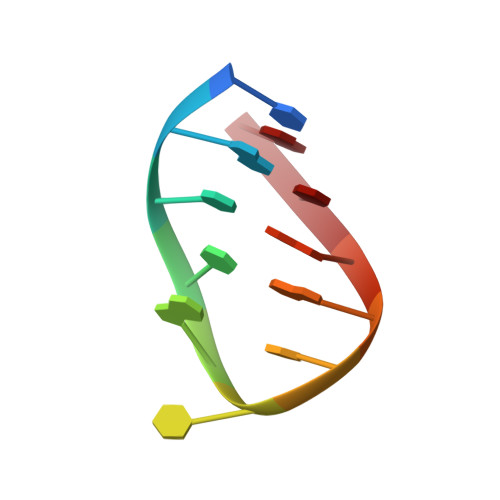NMR study of a heterochiral DNA hairpin:impact of L-enantiomery in the loop.
El Amri, C., Mauffret, O., Santamariar, F., Tevanian, G., Rayner, B., Fermandjian, S.(2001) J Biomol Struct Dyn 19: 459-470
- PubMed: 11790144
- DOI: https://doi.org/10.1080/07391102.2001.10506754
- Primary Citation of Related Structures:
1FV8 - PubMed Abstract:
We carried out a structural study of the DNA heterochiral strand d (AGCTTATCAT(L)CGATAAGCT), -AT(L)C-, where T(L) (L thymine ) replaces T (natural D-thymine). -AT(L)C- is a structural analog of -ATC- that belongs to a strong topoisomerase II DNA cleavage site and which has been shown to resolve into a hairpin structure with a stem formed by eight Waston-Crick base-pairs and a single residue loop closed by an A.C sheared base-pair. Although - AT(L)C-, like its parent -ATC-, folds into a hairpin structure at low and high DNA concentrations it displays a lower stability (Tm of 56 degrees C versus 58.5 degrees C). Several NMR features in -AT(L)C- account for the disruption of the A.C pairing in the loop and a weakening of the C.G base-pair stability at the stem-loop junction. For instance, the exchange of the loop imino protons with solvent is accelerated compared with the natural oligonucleotide -ATC-. The higher flexibility of the heterochiral loop is confirmed by the results of NMR restrained molecular dynamics. In the calculated final structures of -AT(L)C-, the T10(L) residue moves the A9 and C11 residues away, thus preventing the loop closure through a C.A sheared base-pair and the achievement of a good base-base or sugar-base stacking. Actually, most of the stabilizing interactions present in -ATC- are lost in the heterochiral - AT(L)C- explaining its weaker stability.
Organizational Affiliation:
Department de Biologie et Pharmacologie Structurales, UMR 8532, CNRS, PR2, Institut Gustave-Roussy, 39, rue Camille-Desmoulins, 94805 Villejuif Cedex, France.














